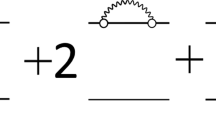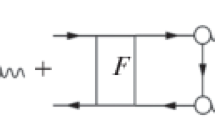Abstract
The self-consistent Theory of Finite Fermi Systems (TFFS) is consistently generalized for the case of accounting for phonon coupling (PC) effects in the energy region of pygmy- and giant multipole resonances (PDR and GMR) in magic nuclei with the aim to consider particle-hole (\(ph\)) and both complex \(1p1h\otimes\textrm{phonon}\) and two-phonon configurations. The article is the direct continuation and generalization of the previous article [1], where \(1p1h\)- and only complex \(1p1h\otimes\textrm{phonon}\) configurations were considered. The newest equation for the TFFS main quantity, the effective field (vertex), which describes the nuclear polarizability, has been obtained. It has considerably generalized the results of the previous article and accounts for two-phonon configurations. Two variants of the newest vertex equation have been derived: (1) the first variant contains complex \(1p1h\otimes\textrm{phonon}\) configurations and the full \(1p1h\)-interaction amplitude \(\Gamma\) instead of the known effective interaction \(F\) in [1], (2) the second one contains both \(1p1h\otimes\textrm{phonon}\) and two-phonon configurations. Both variants contain new, as compared to usual approaches, PC contributions, which are of interest in the energy region under consideration and, at least, should result in a redistribution of the PDR and GMR strength, which is important for the explanation of the PDR and GMR fine structure. The qualitative analysis and discussion of the new terms and the comparison to the known time-blocking approximation are performed.









Similar content being viewed by others
Notes
We write down the standard TFFS expression (2) for the \(ph\)-propagator as the result of integration. However, it is desirable to keep in mind that in following Section 4 it is better to consider the propagator as the product GG of two GFs without integration.
In the article [31], a special case of Eq. (10) was considered, namely, there we considered only the second term from the right side of Eq. (10). It turned out that the final equation was rather cumbersome and does not allowed to reasonably account for two-phonon configurations. The present article considerably improves the results of [31]. Suffice it to compare Fig. 7 in [31], where all the terms are begun on \(F\) or \(\delta F\), and the final figure of the present article.
In the present article, the \(g^{4}\) effects are already considered in the two-phonon graphs. So the arguments in [1] about \(\rho=\int GG\tilde{V}d\varepsilon\) in the \(g^{2}\) approximation are not suitable in our case. However, it does not mean that the \(g^{4}\) effects are not important. They are important just for the fine structure where they will result in the strength redistribution.
REFERENCES
S. P. Kamerdzhiev and M. I. Shitov, Eur. Phys. J. A 56, 265 (2020).
D. Savran, T. Aumann, and A. Zilges, Progr. Part. Nucl. Phys. 70, 210 (2013).
N. Paar, D. Vretenar, E. Khan, and G. Colo, Rep. Prog. Phys. 70, 691 (2007).
A. Bracco, E. G. Lanza, and A. Tamii, Prog. Part. Nucl. Phys. 106, 360 (2019).
S. P. Kamerdzhiev, O. I. Achakovskiy, S. V. Tolokonnikov, and M. I. Shitov, Phys. At. Nucl. 82, 366 (2019).
S. Kamerdzhiev, J. Speth, and G. Tertychny, Phys. Rep. 393, 1 (2004).
A. Tamii, I. Poltoratska, P. von Neumann-Cosel, Y. Fujita, T. Adachi, C. A. Bertulani, J. Carter, M. Dozono, H. Fujita, K. Fujita, K. Hatanaka, D. Ishikawa, M. Itoh, T. Kawabata, Y. Kalmykov, A. M. Krumbholz, et al., Phys. Rev. Lett. 107, 062502 (2011).
A. C. Larsen, J. E. Midtbø, M. Guttormsen, T. Renstrøm, S. N. Liddick, A. Spyrou, S. Karampagia, B. A. Brown, O. Achakovskiy, S. Kamerdzhiev, D. L. Bleuel, A. Couture, L. Crespo Campo, B. P. Crider, A. C. Dombos, R. Lewis et al., Phys. Rev. C 97, 054329 (2018).
A. Repko, V. O. Nesterenko, J. Kvasil, and P.-G. Reinhard, Eur. Phys. J. A 55, 242 (2019).
N. Ryezayeva, T. Hartmann, Y. Kalmykov, H. Lenske, P. von Neumann-Cosel, V. Yu. Ponomarev, A. Richter, A. Shevchenko, S. Volz, and J.Wambach, Phys. Rev. Lett. 89, 272502 (2002).
N. A. Lyutorovich, V. I. Tselyaev, O. I. Achakovskiy, and S. P. Kamerdzhiev, JETP Lett. 107, 659 (2018).
A. B. Migdal, Theory of Finite Fermi Systems and Applications to Atomic Nuclei (Nauka, Moscow, 1965; Intersci., New York, 1967).
V. A. Khodel and E. E. Saperstein, Phys. Rep. 92, 183 (1982).
A. B. Migdal, Theory of Finite Fermi Systems and Applications to Atomic Nuclei, 2ed ed. (Nauka, Moscow, 1983; Intersci., New York, 1967).
E. E. Saperstein and S. V. Tolokonnikov, Phys. At. Nucl. 79, 1030 (2016).
D. Voitenkov, S. Kamerdzhiev, S. Krewald, E. E. Saperstein and S. V. Tolokonnikov, Phys. Rev. C 85, 054319 (2012).
S. P. Kamerdzhiev, Sov. J. Nucl. Phys. 38, 188 (1983).
V. I. Tselyaev, Sov. J. Nucl. Phys. 50, 780 (1989).
V. I. Tselyaev, Phys. Rev. C 75, 024306 (2007).
A. Avdeenkov, S. Goriely, S. Kamerdzhiev, and S. Krewald, Phys. Rev. C 83, 064316 (2011).
S. P. Kamerdzhiev and V. N. Tkachev, Z. Phys. A 334, 19 (1989).
S. P. Kamerdzhiev and V. N. Tkachev, Phys. Lett. B 142, 225 (1984).
P. F. Bortignon and R. A. Broglia, Nucl. Phys. A 371, 405 (1981).
P. F. Bortignon, R. A. Broglia, G. F. Bertsch, and J. Pacheco, Nucl. Phys. A 460, 149 (1986).
S. P. Kamerdzhiev, A. V. Avdeenkov, and O. I. Achakovskiy, Phys. At. Nucl. 77, 1303 (2014).
V. Tselayev, N. Lyutorovich, J. Speth and P.-G. Reinhard, Phys. Rev. C 97, 044308 (2018).
E. Litvinova and P. Schuck, Phys. Rev. C 100, 064320 (2019).
V. G. Soloviev, Theory of Atomic Nuclei: Quasiparticles and Phonons (Inst. Physics, Bristol and Philadelphia, USA, 1992).
F. Knapp, N. Lo Iudice, P. Vesely, F. Andreozzi, G. De Gregorio, and A. Porrino, Phys. Rev. C 92, 054315 (2015).
V. A. Khodel, A. P. Platonov, and E. E. Saperstein, J. Phys. G: Nucl. Phys. 6, 1199 (1980).
S. P. Kamerdzhiev and M. I. Shitov, Phys. At. Nucl. 84, 649 (2021).
E. Litvinova, P. Ring, and V. Tselyaev, Phys. Rev. C 88, 044320 (2013).
V. I. Tselyaev, Phys. Rev. C 88, 054301 (2013).
V. Tselyaev, N. Lyutorovich, J. Speth, P.-G. Reinhard, and D. Smirnov, Phys. Rev. C 99, 064329 (2019).
V. Tselyaev, N. Lyutorovich, J. Speth, and P.-G. Reinhard, Phys. Rev. C 102, 064319 (2020).
L. M. Donaldson, J. Carter, P. von Neumann-Cosel, V. O. Nesterenko, R. Neveling, P.-G. Reinhard, I. T. Usman, P. Adsley, C. A. Bertulani, J. W. Brümmer, E. Z. Buthelezi, G. R. J. Cooper, R. W. Fearick, S. V. Förtsch, H. Fujita, et al., Phys. Rev. C 102, 064327 (2020).
ACKNOWLEDGMENTS
We are grateful to V.A. Khodel, and V.I. Tselayev for useful discussions and to D.A. Voitenkov for help. S.K. thanks Dr. A.C. Larsen and the Oslo group for stimulating cooperation in the PDR field.
Funding
The article was funded by the internal grant of National Research Center Kurchatov Inctitute (Order No. 2767 of 28.10.21).
Author information
Authors and Affiliations
Corresponding author
Rights and permissions
About this article
Cite this article
Kamerdzhiev, S., Shitov, M. New Equation for the Vertex of Theory of Finite Fermi-Systems: Accounting for Phonon Coupling. Phys. Atom. Nuclei 84, 804–816 (2021). https://doi.org/10.1134/S1063778821130159
Received:
Revised:
Accepted:
Published:
Issue Date:
DOI: https://doi.org/10.1134/S1063778821130159




